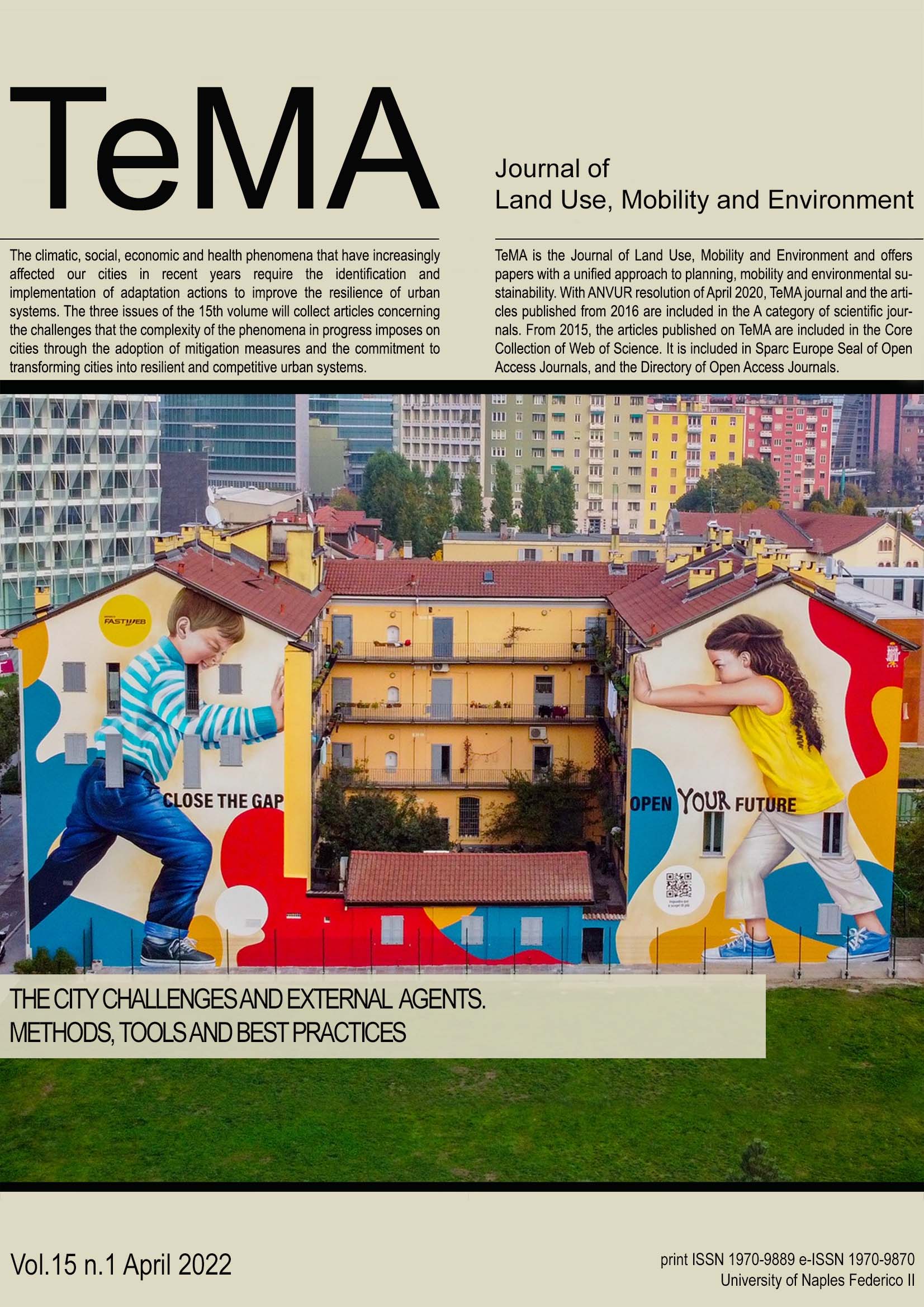The interventions of the Italian Recovery and Resilience Plan: Urban regeneration of the Italian cities
Abstract
Starting from the relationship between urban planning and mobility management, TeMA has gradually expanded the view of the covered topics, always following a rigorous scientific in-depth analysis. This section of the Journal, Review Notes, is the expression of a continuous updating of emerging topics concerning relationships among urban planning, mobility and environment, through a collection of short scientific papers. The Review Notes are made of five parts. Each section examines a specific aspect of the broader information storage within the main interests of TeMA Journal.
This section of the Review Notes explores a specific topic, related to cities, within the framework of the European program NextGenerationEU.
This contribution deepens the topic of urban regeneration, providing an overview of the urban regeneration measures in the Italian Recovery and Resilience Plan and deepening how these measures are intended to make Italian cities more sustainable and inclusive. Furthermore, it highlights the main strategies, reforms, and interventions for urban regeneration, which have been activated in Italian cities, thanks to the NRRP investments.
Downloads
References
Bianconi, F., Clemente, M., Filippucci, M., & Salvati, L. (2018). Regenerating Urban Spaces: A Brief Commentary on Green Infrastructures for Landscape Conservation. TeMA-Journal of Land Use, Mobility and Environment, 11(1), 107-118.
Corriere della sera (2021). Brescia, Torre Tintoretto addio: sarà rimpiazzata da 270 abitazioni ad housing sociale. Retrieved from:https://brescia.corriere.it/notizie/cronaca/21_aprile_28/brescia-torre-tintoretto-addio-sara-rimpiazzata-270-bitazioni-ad-housing- sociale-6013e76e-a7f6-11eb-9b2a-89b9894068db.shtml
Degen, M., & García, M. (2012). The transformation of the ‘Barcelona model’: an analysis of culture, urban regeneration and governance. International journal of urban and regional research, 36(5), 1022-1038. https://doi.org/10.1111/j.1468-2427.2012.01152.x
European Commission (2021). NextGenerationEU. Retrieved from: https://ec.europa.eu/info/strategy/recovery-plan-europe
Gaglione, F., & Ayiine-Etigo, D. A. (2021). Resilience as an urban strategy: a comparison of resources and interventions in the European Recovery Plans for the green transition. TeMA-Journal of Land Use, Mobility and Environment, 14(3), 501-506. https://doi.org/10.6093/1970-9870/8303
Gargiulo, C., & Sgambati, S. (2022). Active mobility in historical districts: towards an accessible and competitive city. The case study of Pizzofalcone in Naples. TeMA-Journal of Land Use, Mobility and Environment, 31-55. https://doi.org/10.6093/1970-9870/8395
Governo Italiano (2021). Italia domani. Piano Nazionale di Ripresa e Resilienza. Retrieved from: https://italiadomani.gov.it/en/home.html
Güzey, Ö. (2009). Urban regeneration and increased competitive power: Ankara in an era of globalization. Cities, 26(1), 27-37. https://doi.org/10.1016/j.cities.2008.11.006
IlSole24ore (2021). Il Pnrr parte da città e periferie: via a 159 progetti per 2,8 miliardi. Ecco dove. Di Giorgio Santilli, 8 ottobre 2021. Retrieved from: https://www.ilsole24ore.com/art/il-pnrr-parte-citta-e-periferie-via-159-progetti-28-miliardi-ecco-dove-AEx6i1n
la Repubblica (2021). Pnrr, un miliardo per Bari: così entro il 2026 può cambiare volto. Retrieved from: https://bari.repubblica.it/cronaca/2021/11/16/news/pnrr_un_miliardo_per_bari_cosi_entro_il_2026_puo_cambiare_volto-326511853/
LA STAMPA (2021). Dalla rinascita del Lungosesia al centro storico, i progetti di Vercelli tra i migliori d’Italia: arriva un maxi finanziamento da 41 milioni. Retrieved from: https://www.lastampa.it/topnews/edizioni-locali/vercelli/2021/07/23/news/ dalla-rinascita-del-lungosesia-al-centro-storico-i-progetti-di-vercelli-tra-i-migliori-d-italia-arriva-un-maxi-finanziamento-da-41-milioni-1.40525132/
Mazzeo, G. (2018). Caratteri urbani della resilienza. Aspetti teorici e prospettive di applicabilità. In Sviluppare, rigenerare, ricostruire città. INU Edizioni. ISBN 978-88-76033-184-7
Mecca, B., & Lami, I. M. (2020). The appraisal challenge in cultural urban regeneration: an evaluation proposal. Abandoned Buildings in Contemporary Cities: Smart Conditions for Actions, 49-70. https://doi.org/10.1007/978-3-030-35550-0_5
Ng, M. K. (2005). Quality of life perceptions and directions for urban regeneration in Hong Kong. In Quality-of-life research in Chinese, Western and Global Contexts. 441-465. Springer, Dordrecht. https://doi.org/10.1007/1-4020-3602-7_15
Openopolis (2021) Rigenerazione urbana, tra tempi stretti e trasparenza. Published on 1st November 2021. Retrieved from: https://www.openpolis.it/rigenerazione-urbana-tra-tempi-stretti-e-trasparenza/
Roberts, P., Sykes, H., & Granger, R. (Eds.). (2016). Urban regeneration. Sage.
Copyright (c) 2022 TeMA - Journal of Land Use, Mobility and Environment

This work is licensed under a Creative Commons Attribution 4.0 International License.
Authors who publish in this journal agree to the following:
1. Authors retain the rights to their work and give in to the journal the right of first publication of the work simultaneously licensed under a Creative Commons License - Attribution that allows others to share the work indicating the authorship and the initial publication in this journal.
2. Authors can adhere to other agreements of non-exclusive license for the distribution of the published version of the work (ex. To deposit it in an institutional repository or to publish it in a monography), provided to indicate that the document was first published in this journal.
3. Authors can distribute their work online (ex. In institutional repositories or in their website) prior to and during the submission process, as it can lead to productive exchanges and it can increase the quotations of the published work (See The Effect of Open Access)

